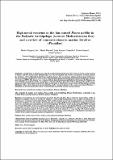Por favor, use este identificador para citar o enlazar a este item:
http://hdl.handle.net/10261/318170COMPARTIR / EXPORTAR:
 SHARE SHARE
 CORE
BASE CORE
BASE
|
|
| Visualizar otros formatos: MARC | Dublin Core | RDF | ORE | MODS | METS | DIDL | DATACITE | |

| Título: | High metal contents in the fan mussel Pinna nobilis in the Balearic Archipelago (western Mediterranean Sea) and a review of concentrations in marine bivalves (Pinnidae) |
Otros títulos: | Alto contenido de metales en el molusco Pinna nobilis en el Archipiélago Balear (Mediterráneo occidental) y una revisión de las concentraciones en bivalvos marinos (Pinnidae) | Autor: | Vázquez-Luis, Maite; Morato, Mercé; Campillo-González, Juan Antonio; Guitart-Ferrarons, Carlos; Deudero, Salud CSIC ORCID | Palabras clave: | Medio Marino trace metal Centro Oceanográfico de Baleares bivalve mollusc bioaccumulation Pinnidae Mytilidae Metales traza bivalvo molusco bioacumulación |
Fecha de publicación: | mar-2016 | Citación: | Scientia Marina, 80(1). 2016: 111-122 | Resumen: | Summary: Concentrations of metals (Cd, Cu, Hg, Pb and Zn) in the marine bivalve Pinna nobilis at several coastal locations of Majorca and the Cabrera Islands (Mediterranean Sea) were investigated. The elevated concentrations of metals found in the soft tissues of P. nobilis indicate high bioaccumulation factors. All concentrations and the calculated metal pollution index showed significant differences between sites, with particularly high concentrations in the Cabrera Archipelago, a marine protected area (MPA). The datasets were evaluated with the limited information published in the literature for Pinnidae species worldwide. In benthic P. nobilis, concentrations of Cd, Cu and Zn are more than 30 times higher and Hg and Pb concentrations are 4 and 7 times higher, respectively, than concentrations in other bivalve species, such as Mytilus galloprovincialis (Mytilidae). These observations from species inhabiting nearby ecological habitats of the coastal environment (Pinnidae vs. Mytilidae) are also discussed in the context of current marine monitoring strategies and assessments Resumen: Se investigaron las concentraciones de metales (Cd, Cu, Hg, Pb y Zn) en el bivalvo marino Pinna nobilis en diferentes localidades costeras de las Islas de Mallorca y Cabrera (Mar Mediterráneo). Las elevadas concentraciones de metales que se encontraron en los tejidos blandos de P. nobilis revelaron una elevada bioacumulación. Las concentraciones de metales estudiadas, así como el índice de contaminación por metales (ICM) mostraron diferencias significativas entre los sitios, con concentraciones particularmente altas en el archipiélago de Cabrera, un área marina protegida (AMP). Se realizó una revisión bibliográfica de la escasa información publicada sobre las especies de la familia Pinnidae a nivel mundial. En comparación con otras especies de bivalvos, como Mytilus galloprovincialis (Mytilidae), la especie bentónica P. nobilis presentó concentraciones más de 30 veces superiores para Cd, Cu y Zn; y hasta 4 y 7 veces para Hg y Pb, respectivamente. La información recabada sobre estas especies que habitan en ecosistemas costeros (Pinnidae vs. Mytilidae) es discutida en el contexto de las actuales estrategias marinas de seguimiento y evaluación |
URI: | http://hdl.handle.net/10261/318170 | DOI: | 10.3989/scimar.04255.24B | ISSN: | 0214-8358 |
| Aparece en las colecciones: | (IEO) Artículos |
Ficheros en este ítem:
| Fichero | Descripción | Tamaño | Formato | |
|---|---|---|---|---|
| Vazquez et al_2016.pdf | 399,73 kB | Adobe PDF |  Visualizar/Abrir |
CORE Recommender
SCOPUSTM
Citations
14
checked on 08-may-2024
WEB OF SCIENCETM
Citations
12
checked on 26-feb-2024
Page view(s)
15
checked on 15-may-2024
Download(s)
22
checked on 15-may-2024
Google ScholarTM
Check
Altmetric
Altmetric
Este item está licenciado bajo una Licencia Creative Commons

